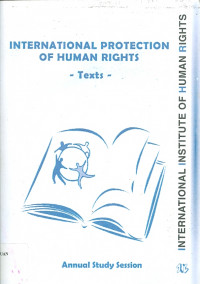
Text
International protection of human rights -texts-
This course aims to provide a comprehensive and analytical account of the application of human rights standards in international law, and the operation of the existing international machinery for the protection of human rights. The course engages with both the theory and practice of human rights law and, in that process, some of the most vexing issues facing us today will be considered. What is the scope of the right to privacy in a digital age? What’s the geographical scope of a state’s human rights obligations? How does human rights law apply in war? What are the human rights obligations of corporations in a globalized landscape? What rights do asylum seekers have when they are fleeing conflict? Does existing law adequately protect women’s rights?
The law of human rights reflects attempts made internationally to articulate basic legal standards for the protection of individuals and groups in their relations with the state, and to use the authority of international law, institutions, and procedures, to secure compliance with such standards. Human rights law is a modern phenomenon; but it has an ancient lineage. Some account of its evolution is given, from natural rights, civil liberties, the history of minorities protection, and the progressive development of human rights in public international law since 1945.
However, the major part of the course relates to post-1945 events concerning the protection of human rights. A section of the course deals with the role and reform of the United Nations to promote and secure the observance, on a universal basis, of international standards of human rights. The development of important legal standards (such as those of non-discrimination) is traced; and the work of various UN bodies in applying and promoting human rights is analyzed.
Availability
| KP.1.000307 | KP.1 INT i | My Library | Available |
Detail Information
- Series Title
-
Annual Study Session
- Call Number
-
KP.1 INT i
- Publisher
- Strasbourg : International Institute of Human Rights., 455
- Collation
-
455 hal.; 29 cm
- Language
-
English
- ISBN/ISSN
-
-
- Classification
-
KP.1
- Content Type
-
-
- Media Type
-
-
- Carrier Type
-
-
- Edition
-
-
- Subject(s)
- Specific Detail Info
-
-
- Statement of Responsibility
-
-
Other version/related
No other version available
File Attachment
Comments
You must be logged in to post a comment
 Computer Science, Information & General Works
Computer Science, Information & General Works  Philosophy & Psychology
Philosophy & Psychology  Religion
Religion  Social Sciences
Social Sciences  Language
Language  Pure Science
Pure Science  Applied Sciences
Applied Sciences  Art & Recreation
Art & Recreation  Literature
Literature  History & Geography
History & Geography